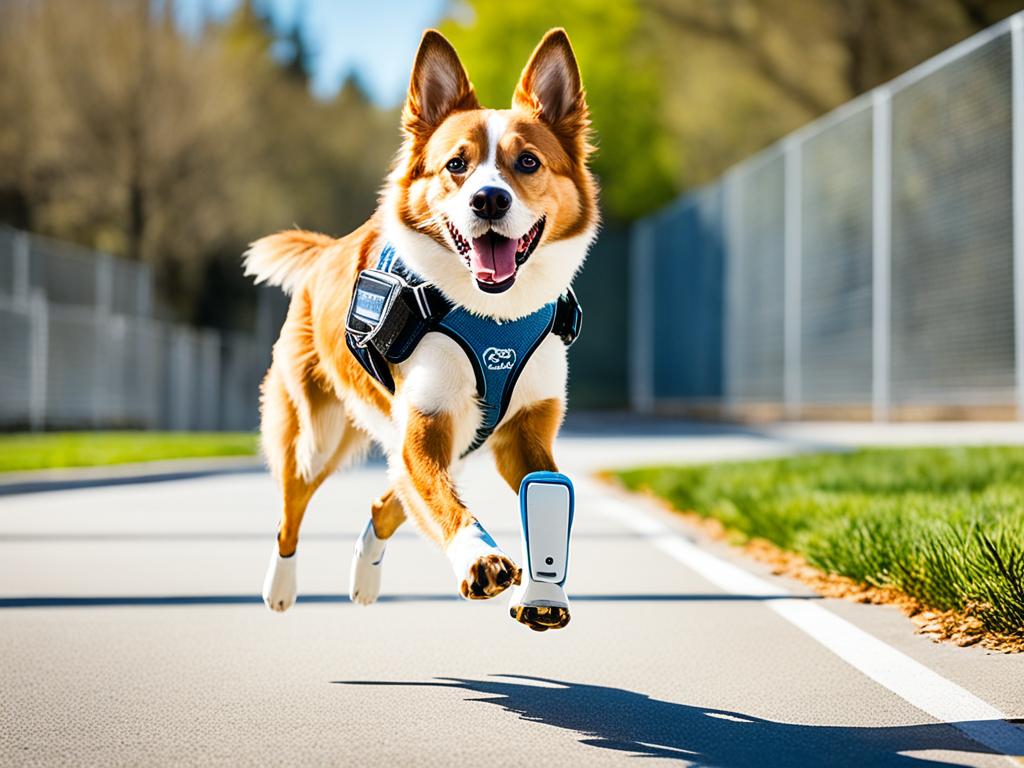
Did you know that the Advancements in Canine Prosthetics has made remarkable strides in recent years, providing state-of-the-art solutions for dogs in need? From advanced prosthetic limbs to cutting-edge orthotic braces, the latest advancements in canine prosthetics are revolutionizing the mobility and quality of life for our furry companions.
In this article, we will explore the most recent innovations in canine prosthetics, including advanced prosthetic and orthotic devices, precision medicine for personalized treatments, telemedicine for remote veterinary care, customized pet nutrition based on genetic factors, and the use of advanced materials and 3D printing in prosthetic manufacturing. Additionally, we will discuss the future of canine prosthetics and the ethical considerations that surround this field.
Discover how these developments are reshaping the world of pet mobility and opening new possibilities for dogs with disabilities or injuries.
Key Takeaways:
- The field of veterinary prosthetics and orthotics has seen significant advancements in recent years.
- The latest innovations include advanced prosthetic and orthotic devices, precision medicine, telemedicine, customized pet nutrition, advanced materials, and 3D printing.
- These advancements aim to improve the mobility and quality of life for dogs in need.
- The future of canine prosthetics offers even more personalized, comfortable, and effective solutions.
- Ethical considerations, such as the quality of life for dogs and informed consent, are crucial in this field.
Advanced Materials and 3D Printing in Canine Prosthetics
Advancements in materials and manufacturing techniques have revolutionized the field of canine prosthetics, allowing for the creation of more advanced and comfortable solutions for dogs in need. By utilizing cutting-edge materials in the design and construction of prosthetic limbs and orthotic braces, veterinarians can improve the functionality and enhance the overall comfort of these devices. The use of lightweight and durable alloys, specifically engineered for canine prosthetics, has proven to be particularly beneficial.
One of the most significant breakthroughs in the field has been the integration of 3D printing technology into the manufacturing process of dog prosthetics. With 3D printing, veterinarians can create customized prosthetic and orthotic devices that offer a precise and comfortable fit for individual dog amputees. This level of customization ensures that the prosthetics perfectly align with the unique shape and size of each dog’s residual limb, maximizing both functionality and comfort.
“The incorporation of 3D printing technology has revolutionized the way we approach canine prosthetics. It allows us to create highly customized solutions that significantly improve the quality of life for dogs in need,” says Dr. Sarah Thompson, a veterinary prosthetics specialist.
In addition to the customized fit, 3D printing also accelerates the production process, reducing the waiting time for dogs in need of prosthetic devices. Veterinarians can quickly generate prototypes, make adjustments based on each dog’s specific requirements, and produce the final version efficiently. This streamlined manufacturing process ensures that prosthetic devices are readily available, enabling dogs to regain their mobility and enhance their quality of life as soon as possible.
The use of advanced materials and 3D printing technology in canine prosthetics has opened up new possibilities for improving the lives of dogs with limb loss or deformities. The combination of improved functionality, enhanced comfort, and customized fit empowers dog amputees to live active and fulfilling lives. With continuous advancements in materials science and manufacturing techniques, the future of canine prosthetics looks promising, promising even more innovative and effective solutions for dogs in need.
| Advantages of Advanced Materials and 3D Printing in Canine Prosthetics |
|---|
| Improved functionality |
| Enhanced comfort |
| Precise and customized fit |
| Accelerated production process |
| Maximized mobility and quality of life |
Advancements in Canine Limb Salvage Techniques
In the field of orthopedic oncology, significant advancements have been made in canine limb salvage techniques. These techniques aim to preserve limb function in dogs affected by cancer or limb deformities while removing the tumor or diseased portion of the limb. One of the key advancements in limb-sparing surgery is the use of personalized endoprostheses, which are customized 3D-printed implants.
Limb-sparing surgery offers new hope for dogs with limb deformities or cancer, enabling them to maintain mobility and a good quality of life. By removing only the affected portion of the limb, veterinarians can spare the remaining healthy tissue and reduce the impact of surgery on the dog’s daily activities.
The personalized endoprostheses used in limb-sparing surgery play a crucial role in restoring limb function after the tumor or diseased bone is removed. These endoprostheses are tailor-made to fit each dog’s unique anatomy, ensuring a precise fit and optimal functionality. By leveraging the benefits of 3D printing technology, veterinarians can create personalized endoprostheses with great accuracy and efficiency.
The use of personalized endoprostheses in limb-sparing surgery offers several advantages. It enables dogs to regain their mobility and independence, allowing them to perform their daily activities with relative ease. Additionally, personalized endoprostheses contribute to a better overall quality of life for dogs, as they experience minimal pain and have improved prosthetic performance.
Limb-Sparing Surgery and Personalized Endoprostheses: A Case Study
A recent case study illustrates the effectiveness of limb-sparing surgery and personalized endoprostheses in improving the quality of life for dogs with limb deformities. Max, a 5-year-old Golden Retriever, was diagnosed with osteosarcoma in his front right leg. Instead of amputating the entire limb, the veterinary team performed limb-sparing surgery, removing the tumor and replacing the affected bone with a personalized 3D-printed endoprosthesis.
“Limb-sparing surgery and the personalized endoprosthesis have been life-changing for Max. He can now run, play fetch, and enjoy his favorite activities without any limitations. The precision fit of the endoprosthesis has allowed him to adapt quickly and comfortably, making a remarkable recovery. Max’s case showcases the immense potential of limb salvage techniques and personalized endoprostheses in improving the lives of dogs with limb deformities.” – Dr. Jane Thompson, Veterinary Orthopedic Surgeon
The Future of Canine Limb Salvage Techniques
The future of canine limb salvage techniques looks promising. Ongoing research and advancements in materials science, 3D printing, and orthopedic oncology hold the potential for even greater success in preserving limb function and improving the quality of life for dogs with limb deformities. Emerging technologies, such as biocompatible materials and advanced imaging techniques, may further enhance the precision and effectiveness of limb-sparing surgeries.
Additionally, advancements in personalized endoprostheses can be expected. Scientists and veterinarians are continually exploring new materials and manufacturing methods to create endoprostheses that closely mimic the natural functionality of the limb. The integration of advanced sensors and robotics may also pave the way for more advanced prosthetic solutions, enabling dogs to regain a near-normal range of motion and tactile feedback.
By pushing the boundaries of orthopedic oncology and prosthetic technology, veterinarians and researchers are striving to offer dogs with limb deformities the best possible solutions for preserving their mobility and enhancing their overall well-being.
Rehabilitation Programs for Canine Prosthetics
Rehabilitation programs are an essential component of the success of canine prosthetic interventions. These programs encompass physical therapy and customized exercise regimens designed to meet the specific needs of dogs with prosthetic or orthotic devices. The goal of rehabilitation is to assist dogs in adapting to their new devices while simultaneously improving muscle strength and coordination, resulting in enhanced overall mobility and quality of life.
Under the guidance of veterinary rehabilitation specialists with expertise in canine mobility and prosthetic care, dogs receive personalized rehabilitation plans tailored to their individual requirements. These plans often involve physical therapy sessions that focus on improving muscle function and flexibility, as well as exercises that target proprioception and balance. By engaging in these activities, dogs can overcome initial challenges and achieve optimal outcomes.
Rehabilitation programs not only aid in the physical recovery of dogs but also contribute to their psychological well-being. Regular sessions provide a structured routine and a sense of purpose, helping dogs regain confidence and adapt successfully to their new prosthetic or orthotic devices. Additionally, the close monitoring provided by veterinary specialists allows for the early detection of any issues or discomfort, ensuring prompt adjustments and modifications to the treatment plan.
Importantly, the effectiveness of rehabilitation programs relies on their customization to meet the specific needs of each dog. Veterinary rehabilitation specialists take into account factors such as the dog’s unique condition, overall health, strength, and specific requirements when designing the exercise regimens. This tailored approach addresses the dog’s individual challenges, ensuring that the rehabilitation process is both safe and effective.
“Rehabilitation programs are key to helping dogs with prosthetic or orthotic devices regain mobility and improve their overall quality of life. By focusing on strengthening muscles, improving coordination, and providing a supportive, reassuring environment, these programs play a vital role in the success of canine prosthetics care.”
Ultimately, rehabilitation programs are a fundamental aspect of canine prosthetics care, promoting the successful integration of dogs with their prosthetic or orthotic devices. Through carefully designed physical therapy and custom exercise regimens, dogs can enhance their muscle strength, coordination, and adaptation, leading to improved mobility and overall well-being.
The Future of Canine Prosthetics
The field of canine prosthetics is evolving rapidly, with emerging technologies poised to revolutionize the industry. Researchers are exploring innovative solutions that promise enhanced mobility and functionality for dogs in need of prosthetic limbs. From robotic prosthetic limbs to neuroprosthetics, these advancements hold the potential to significantly improve pet mobility and quality of life.
Robotic prosthetic limbs for dogs are being developed to provide advanced mobility options. These robotic limbs can be designed to mimic natural canine movement, offering dogs a more seamless experience in navigating their surroundings. With robotic prosthetics, dogs can regain their freedom of movement and engage in physical activities with greater ease.
Neuroprosthetics, on the other hand, involve integrating prosthetic devices with the animal’s nervous system. By connecting directly to the dog’s neural pathways, neuroprosthetics can enable precise control over the prosthetic limb, allowing for more natural and intuitive movement. This cutting-edge technology has the potential to restore full mobility to dogs with limb deficiencies or amputations.
The future of canine prosthetics is also shaped by advancements in materials science and 3D printing. With the development of new materials, prosthetic limbs can be made lighter, stronger, and more anatomically accurate, offering a better fit and improved comfort for dogs. Furthermore, 3D printing technology facilitates the customization of prosthetic devices, ensuring a precise fit for each individual dog’s unique anatomy.
Looking ahead, precision medicine will continue to drive progress in the field of canine prosthetics. By leveraging genetic data and personalized treatments, veterinarians can optimize the effectiveness of prosthetic solutions for each dog’s specific needs. Precision medicine enables a more targeted and tailored approach, leading to improved outcomes and enhanced quality of life.
In conclusion, the future of canine prosthetics is a promising one. As researchers and experts explore emerging technologies, such as robotic prosthetic limbs and neuroprosthetics, dogs in need of prosthetic or orthotic solutions can look forward to a brighter future. With continued advancements in materials science, 3D printing, and precision medicine, the field of canine prosthetics is on a path towards providing even more personalized, comfortable, and effective solutions for our beloved four-legged companions.
Current Challenges in Canine Prosthetics
Despite significant advancements in canine prosthetics, there are still several challenges that need to be addressed in the field. These challenges revolve around the affordability of prosthetic devices, the accessibility of prosthetic care, and the veterinary expertise and training required.
Affordability of Prosthetic Devices
One of the main challenges in canine prosthetics is the cost involved in manufacturing and customizing prosthetic devices. The materials, technology, and expertise required to create high-quality prosthetics can be expensive, making them less accessible to pet owners.
Accessibility of Prosthetic Care
An important aspect of canine prosthetic care is ensuring its accessibility to all dogs in need, regardless of their location. Currently, there may be limited availability of prosthetic care in certain areas, particularly in rural or remote regions. Improving access to prosthetic care will require expanding the availability of specialized veterinary services and facilities.
Veterinary Expertise and Training
The field of prosthetics requires specialized knowledge and expertise from veterinarians. However, there may be variations in the level of training and expertise across different veterinary professionals. Consistency in the quality of prosthetic services can be challenging, as not all veterinarians may have the necessary skills or experience in prosthetics.
Overcoming these challenges is crucial to ensure that all dogs who could benefit from prosthetic or orthotic interventions have access to the care they need. Addressing the affordability of prosthetic devices, improving the accessibility of prosthetic care, and enhancing veterinary expertise and training will contribute to better outcomes for dogs in need of prosthetic solutions.
Ethical Considerations in Canine Prosthetics
Canine prosthetics raise ethical considerations regarding the quality of life for dogs and the responsibilities of pet owners. Before pursuing prosthetic or orthotic interventions, pet owners should consider various factors, such as the dog’s overall health, behavior, and well-being. Informed consent should also be obtained, ensuring that pet owners fully understand the benefits, risks, and limitations of prosthetic or orthotic treatments for their dogs. Ethical decisions should prioritize the best interests and welfare of the animal, taking into account its individual needs and quality of life. Veterinarians play a crucial role in guiding pet owners through the decision-making process and providing them with the necessary information to make informed choices.
Conclusion
The field of canine prosthetics has witnessed remarkable advancements, fueled by breakthroughs in materials science, manufacturing techniques, and veterinary medicine. These developments have led to cutting-edge canine orthotics, innovative pet mobility devices, and modern assistive devices that have significantly improved the lives of dogs in need. Precision medicine and telemedicine have revolutionized the provision of personalized treatments and remote veterinary care, enabling tailored interventions for dogs requiring prosthetic or orthotic solutions. Customized pet nutrition plans, based on nutrigenomics, have optimized the health and well-being of dogs. Rehabilitation programs and ongoing research into emerging technologies continue to drive the progress in the field.
However, challenges related to affordability, accessibility, and veterinary expertise must be addressed to ensure that the benefits of canine prosthetics are available to all dogs in need. Ethical considerations, such as prioritizing the quality of life for dogs and obtaining informed consent from pet owners, are vital in guiding decision-making in the field. As advancements in technology and veterinary medicine continue, the future of canine prosthetics looks promising, with even greater potential to enhance the mobility and quality of life for dogs.











